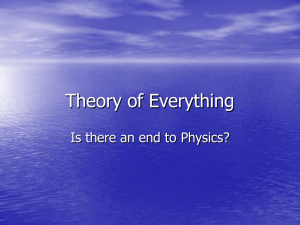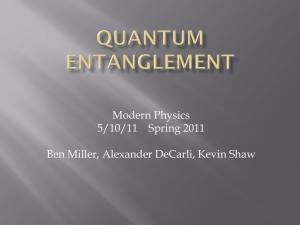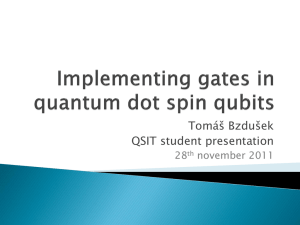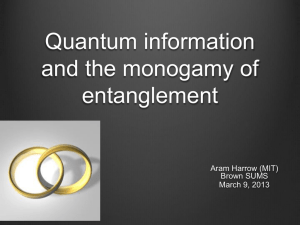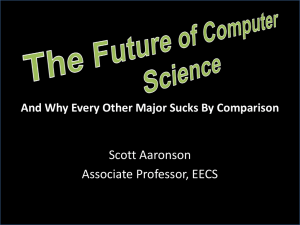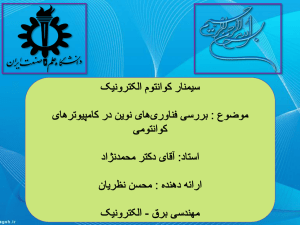ppt - IIT Kanpur
advertisement
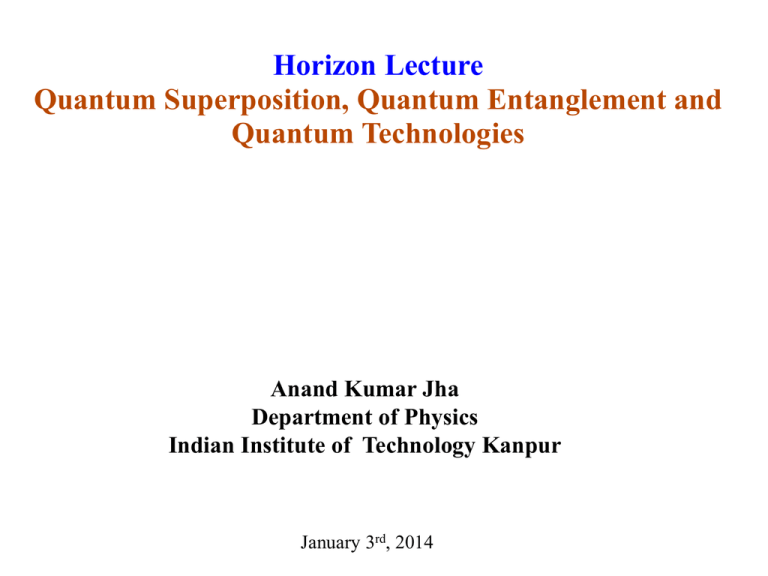
Horizon Lecture Quantum Superposition, Quantum Entanglement and Quantum Technologies Anand Kumar Jha Department of Physics Indian Institute of Technology Kanpur January 3rd, 2014 Outline Quantum Superposition • What is it? • Difference from Classical Superposition • Applications/Technologies Quantum Entanglement • What is it? • Is there any classical analog? • Application/Technologies Declaration “..it is safe to say no one really understands quantum mechanics” – R. P. Feynman “ All these fifty years of conscious brooding have brought me no nearer to the answer to the question, 'What are light quanta?' Nowadays every Tom, Dick and Harry thinks he knows it, but he is mistaken.” --- Albert Einstein What is light ?? waves particles 17th Century: Light was made up of Particles (Newton’s theory) 1801-1900: Light was a wave (Young’s double slit experiment) 1900- : Light is wave as well as particle (Planck’s hypothesis: E=nhn; Photoelectric effect.) Image source: Wikepedia and google images Light is wave (Young’s double slit experiment) Light is wave (Young’s double slit experiment) Light is wave (Young’s double slit experiment) Superposition (Classical Wave theory): Division of amplitude (= Division of energy) Superposition of amplitudes (Interference) Light is Particles (Young’s double slit experiment) Light is Particles (Young’s double slit experiment) Image source: Wikepedia and google images Light is Particles (Young’s double slit experiment) Image source: Wikepedia and google images Light is Particles (Young’s double slit experiment) Image source: Wikepedia and google images Light is Particles (Young’s double slit experiment) Image source: Wikepedia and google images Light is Particles (Young’s double slit experiment) Image source: Wikepedia and google images Light is Particles as well as Waves Superposition (Quantum)?? Image source: Wikepedia and google images Light is Particles as well as Waves Superposition (Quantum) - A photon goes through either slit#1 or slit#2 - Photons hit the screen at well localized points - Photon distribution is the interference pattern Image source: Wikepedia and google images Light is Particles as well as Waves Superposition (Quantum) - Any effort to get the which-slit (particle) information destroys the interference (wave) information to the same degree. --- Bohr’s Complementarity Principle Image source: Wikepedia and google images Bohr’s Complementarity Principle NPBS Polarizer D |V> screen |45> laser |H> PBS Polarizer D, absent Polarizer D at 45 No Fringes Fringes Light is Particles as well as Waves Superposition (Quantum): “Each photon then interferes with itself. Interference between two different photons never occur.” --- Dirac (in Principles of Quantum Mechanics) Image source: Wikepedia and google images Light is Particles as well as Waves Superposition (Quantum): Division of wave-function (≠ Division of energy) Superposition of wave-functions (Interference) Image source: Wikepedia and google images Light is Particles as well as Waves Superposition (Classical Wave theory): Division of amplitude (= Division of energy) Superposition of amplitudes (Interference) Superposition (Quantum): Division of wave-function (≠ Division of energy) Superposition of wave-functions (Interference) Fundamentally incorrect, but applicable at high light-levels. Inadequate at single-photon levels. Fundamentally correct, but may be necessary only at single-photon levels. Quantum Superposition: Application (Quantum Cryptography) Older Method (scylate) Modern Method Message: Encrypt with Key: Encrypted message: OPTICS 010110 OQTJDS Encrypted message: Decrypt with Key: Decrypted Message: OQTJDS 010110 OPTICS Image source: Wikepedia and google images Quantum Superposition: Application (Quantum Cryptography) Older Method (scylate) Modern Method Message: Encrypt with Key: Encrypted message: OPTICS Encrypted message: Decrypt with Key: 010110 OQTJDS Decrypted Message: OQTJDS 010110 OPTICS Main issue: Security Future? “Quantum Cryptography” --- perfectly secure because of the laws of quantum mechanics. Image source: Wikepedia and google images Quantum Superposition: Application (Quantum Cryptography) U What are those laws ? 1. Measurement in an incompatible basis changes the quantum state 2. No Cloning Theorem: • C cannot clone an arbitrary quantum state sent out by A Quantum Entanglement Entangled Einstein objected to this kind of phenomenon EPR Paradox One photon system: Δx Δp ≥ /2 Diffracting wave Plane-wave Momentum is the Physical Reality Position is the Physical Reality “When the operators corresponding to two physical quantities do not commute the two quantifies cannot have simultaneous reality.” -- EPR rephrasing the uncertainty relation. Two-photon system (Entangled): 1 Δx(1)cond Δp(1)cond < /2 Non-local correlation ??? 2 EPR’s Questions: (1) Is Quantum mechanics incomplete?? (2) Does it require additional “hidden variables” to explain the measurement results. Quantum Entanglement Verified • 1950s: hidden variable quantum mechanics by David Bohm • 1964: Bell’s Inequality--- A proposed test for quantum entanglement • 1980s -90s --- Experimental violations of Bell’s inequality. | S | 2 For hidden variable theories | S | 2 2 For quantum correlations Violation Image source: Wikepedia and google images Source of Entanglement/ Type of Entanglement - Entanglement in position and momentum - Entanglement in time and energy - Entanglement in angle and orbital angular momentum - Entanglement in Polarization Two-dimensional entanglement Continuous-variable entanglement What is Entanglement (Polarization) H-polarized cone from 1 45 0 H V H s H i VsVi 1 2 V-polarized cone from 2 (1) If signal photon has horizontal (vertical) polarization, idler photon is guaranteed to have horizontal (vertical) polarization --- Is this entanglement ?? NO --- Two independent classical sources can also produce such correlations What is Entanglement (Polarization) H-polarized cone from 1 45 0 H V H s H i VsVi 1 2 V-polarized cone from 2 (1) If signal photon has horizontal (vertical) polarization, idler photon is guaranteed to have horizontal (vertical) polarization --- Is this entanglement ?? NO --- Two independent classical sources can also produce such correlations V H s Hi Vs Vi H 45 s 45 i 45 s 45 i (2) If signal photon has 450 (-450) polarization, idler photon is guaranteed to have 450 (-450) polarization --- Is this entanglement ?? NO If correlations (1) and (2) exist simultaneously, then that is entanglement Quantum Superposition with Entangled Photons Hong-Ou-Mandel Effect C. K. Hong et al., PRL 59, 2044 (1987) Image source: Wikepedia and google images Quantum Superposition with Entangled Photons Hong-Ou-Mandel Effect C. K. Hong et al., PRL 59, 2044 (1987) Bunching of photons at a beam splitter ---- Applications in quantum metrology Image source: Wikepedia and google images Quantum Superposition with Entangled Photons Hong-Ou-Mandel Effect C. K. Hong et al., PRL 59, 2044 (1987) Is this interference between two different phtons? Is Dirac’s statement incorrect? - NO Here, a two-photon is interfering with itself Image source: Wikepedia and google images Quantum Entanglement: Applications 1. Quantum Cryptography with Entangled photons A. Zeilinger. Oct. 20, 2008. “Photonic Entanglement and Quantum Information” Plenary Talk at OSA FiO/LS XXIV 2008, Rochester, NY. 2. Quantum Teleportation - Quantum states (not system) can be teleported from point A to point B - Record is Teleportation over 144 km --- Ursin et al., Nature Physics, 3(7), 481-486 (2007). 3. Quantum Computing (building a quantum computer) - Solving quantum-mechanical problem, Prime factorization, Database search 4. Quantum Metrology Imaging with enhanced resolution and/or sensitivity. Conclusions - Superposition principle and entanglement and the two hallmark effects of quantum mechanics. - The next-generation quantum technologies could be based on these two effects. Acknowledgments: - Members of the Physics Society The Physics department Further Interactions: - Quantum Information and Coherence (QuIC) talks, Tuesdays 4-5 pm. Conclusions - Superposition principle and entanglement and the two hallmark effects of quantum mechanics. - The next-generation quantum technologies could be based on these two effects. Acknowledgments: - Members of the Physics Society The Physics department Further Interactions: - Quantum Information and Coherence (QuIC) talks, Tuesdays 4-5 pm. Thank you all for your attention


